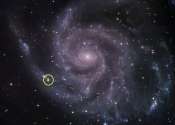Fermi telescope detects the highest-energy light from a solar flare
(Phys.org)—During a powerful solar blast on March 7, NASA's Fermi Gamma-ray Space Telescope detected the highest-energy light ever associated with an eruption on the sun. The discovery heralds Fermi's new role as a solar ...









